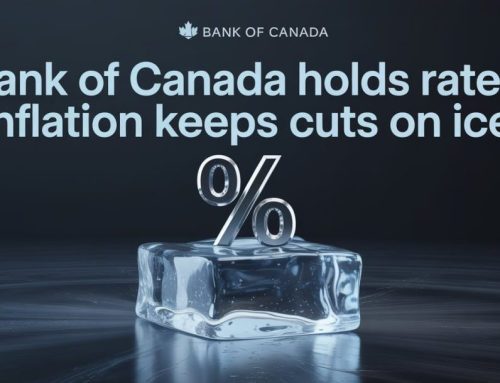Despite widespread anticipation of rate cuts from the Bank of Canada, fixed mortgage rates continue with their upward climb. It’s a common misconception that when the BoC slashes its rate, fixed mortgage rates will follow suit, dropping by an equivalent margin. However, this assumption doesn’t always hold true. While there’s a possibility that fixed rates could dip after a BoC cut, there’s no guarantee; they can remain unchanged or even increase further.
Currently, upward pressure on fixed mortgage rates continues, showing no signs of letting up.
Rising Fixed Rate Mortgages
Bond yields continue to climb higher and have been in an upward trend for the past month. As bond yields are one of the primary drivers of fixed mortgage rate pricing, we’ve seen rates increase by 0.20% to 0.35%, depending on the lender. The yields are up almost 2% today (Wednesday, April 24th), setting the stage for potential further increases to fixed mortgage rates.
This is the highest that bond yields have been since mid-November, 2023. At the time, the lowest 5-year fixed rate for an insured mortgage was 5.39%. Fast forward to today and the lowest rate for the same mortgage is 4.79%–a substantial difference of 0.60%. This doesn’t mean that mortgage lenders will be jacking up their insured rates by this margin, but the possibility cannot be overlooked.
Mortgage lenders will generally price their fixed rate mortgages at 1.00 to 2.00% above the bond yield. With the yields currently at 3.86%, it positions the 5-year fixed rates in a bracket between 4.86% and 5.86%. Currently, the lowest 5-year fixed rates range from 4.79% to 5.19% for owner occupied properties across all mortgage rate categories.
This means that there is potential for fixed mortgage rates to increase without any further movement in bond yields. But if lenders needed to hike their rates by large margins, then they would have already done so. This doesn’t mean we’re in the clear against large increases to fixed rates, but lenders seem to be making the effort to keep them down. That said, if the yields continue to rise then they’ll have no choice but to come through with more hikes to their fixed rates.
Time to Lock in a Fixed Mortgage Rate
If you have a new home purchase or a mortgage renewal closing within the next 120 days, then I would recommend reaching out to us to get a rate locked ASAP. This is the only way to protect yourself against rising rates. I still think it’s likely that we’ll see the trend reverse, but this is far from a guarantee.
If rates drop, we can still get your rate lowered, often right up until the week before the funding date on your new mortgage. If another lender comes out with a lower rate, then we can switch you to that lender, providing there is enough time left to do so. It doesn’t matter if you’ve already signed the documents yet or not, we can still make the move should something better become available. We’ll do the rate shopping so you don’t have to, saving you not just money, but time as well.
Updated Forecasts from the Big Six Banks
Despite the upward trend in bond yields, it’s still possible that we could see the first cut from the Bank of Canada with their next scheduled announcement on June 5th. Three of the big banks are forecasting a cut on this date, with the remaining three putting their money on a cut in the 3rd quarter. Should the less optimistic banks be correct, then our sights would then shift to the next scheduled announcement on July 24th. I personally think that a cut in July is more probable than a cut in June. We’ll find out soon enough.
Here are what the banks are currently forecasting:
| 2024 | 2025 | TOTAL | ||||||
|---|---|---|---|---|---|---|---|---|
| June 5 | Q3 | Q4 | Q1 | Q2 | Q3 | Q4 | ||
| CIBC | -0.25% | -0.50% | -0.50% | -0.50% | -0.25% | -0.25% | -0.25% | -2.50% |
| RBC | -0.25% | -0.50% | -0.25% | -0.25% | -0.50% | -0.25% | N/C | -2.00% |
| Scotia | N/C | -0.25% | -0.50% | -0.50% | -0.25% | -0.25% | N/C | -1.75% |
| TD | N/C | -0.50% | -0.50% | -0.50% | -0.50% | -0.50% | -0.25% | -2.75% |
| BMO | -0.25% | -0.25% | -0.25% | -0.25% | -0.25% | N/C | -0.25% | -1.50% |
| National Bank | N/C | -0.25% | -0.50% | -0.50% | -0.25% | -0.25% | -0.25% | -2.00% |
These are the forecasts as of now, but they can and will change as time passes. They can be accurate, but they can also be radically wrong. An economist can only go by the information they have available to them at the time. As new information becomes available, the forecasts will be adjusted accordingly.
Conclusion
Long range rate forecasting can be much like long range weather forecasting. Just as meteorologists try to predict sunshine or showers weeks in advance, economists will do their best to forecast prime rate movement. They both provide a general outlook, and the further out the prediction, the less likely it is to be accurate.
While bond yields are currently trending upward, they will eventually reverse. The problem is that we don’t know when the trend will break or whether we’ll see more jumps in fixed rates along the way.
I remain optimistic that it will be soon, but optimism isn’t enough to base a decision on. For this reason, make sure you get a rate locked as soon as possible. It’s the only way to protect yourself should the rates increase. This doesn’t mean you’re stuck with this rate if better deals become available. We’re always monitoring rates for our clients and often get them dropped, sometimes right up until a few days before the mortgage funding date. Even if you’ve already signed the documents. This is all part of the service that we offer as we’re committed to saving you as much money as possible.








Leave A Comment